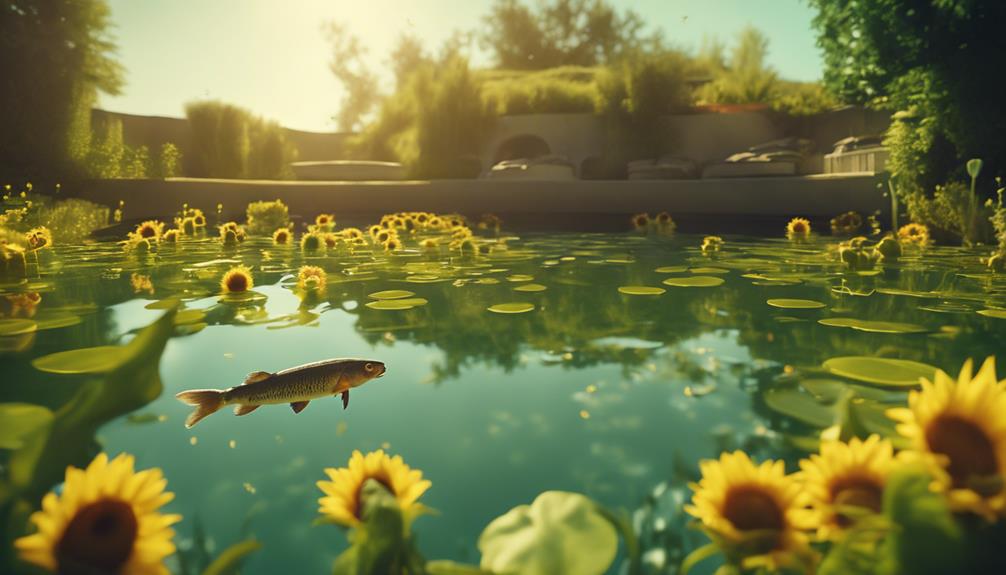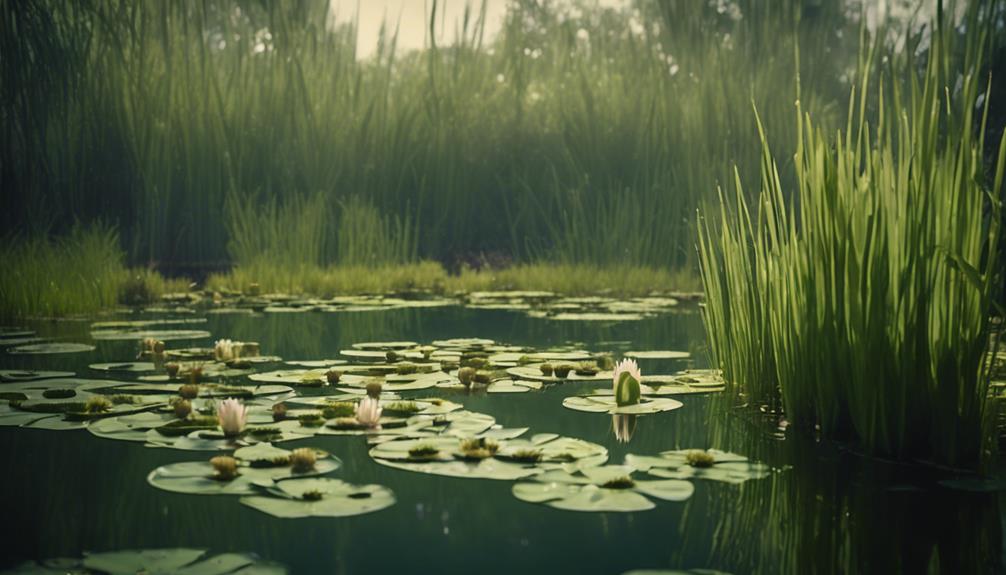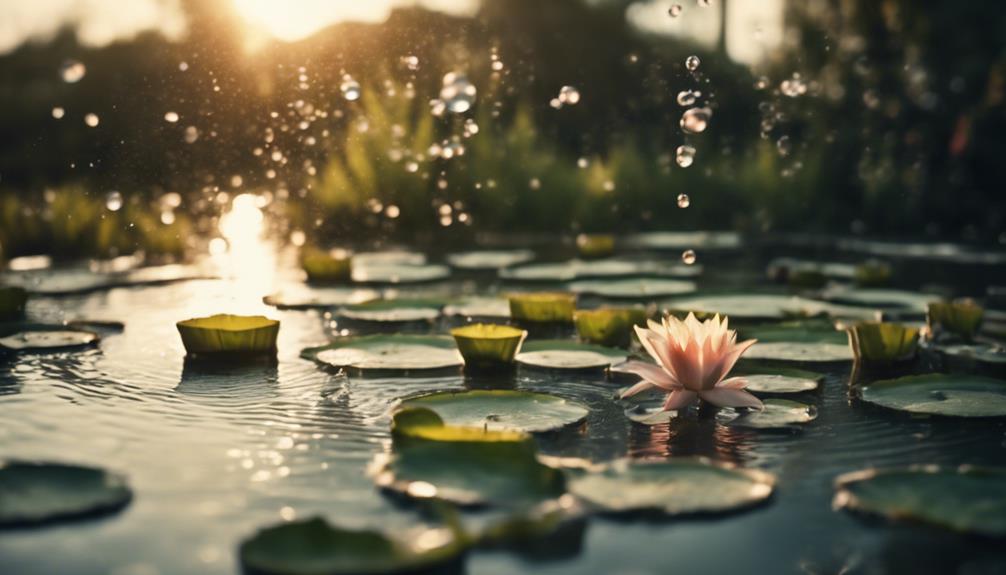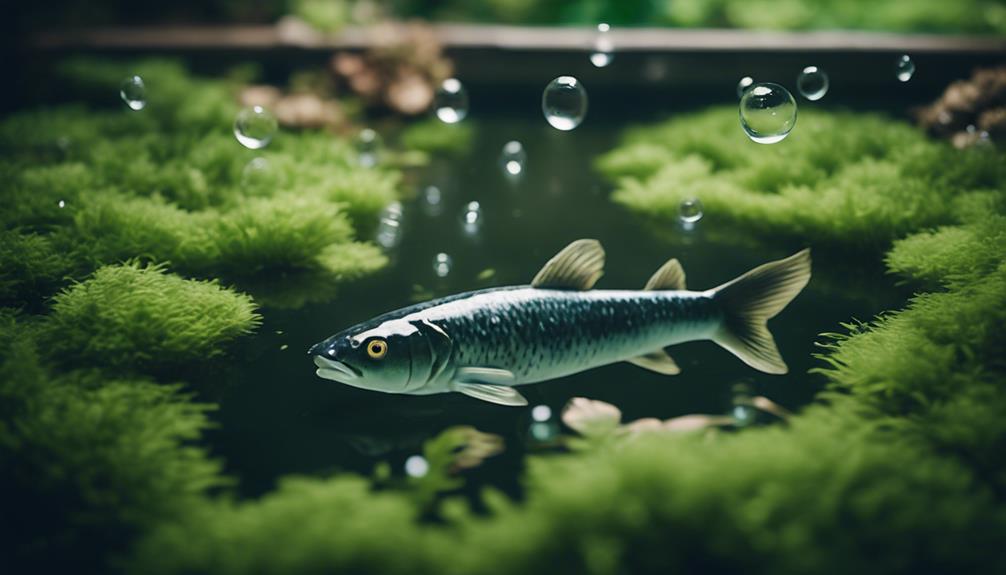You can boost oxygen levels in your fish pond naturally by incorporating aeration systems, promoting photosynthesis, and maintaining healthy water circulation. Portable aerators provide rapid oxygenation during emergency situations, while fixed aeration systems offer a long-term solution. Natural oxygen boosters like water lilies and cattails absorb carbon dioxide and release oxygen through photosynthesis. Supplementing with pure oxygen guarantees ideal levels, especially during critical periods. By combining these methods and maintaining healthy plant growth, you can create a thriving ecosystem for your fish. Now, explore how to fine-tune your approach for perfect oxygen levels and a balanced pond environment.
Table of Contents
Key Takeaways
- Incorporate oxygen-rich plants like water lilies, cattails, or algae to absorb carbon dioxide and release oxygen through photosynthesis.
- Install pond pumps or fountains to increase oxygen levels while improving water circulation and aesthetics.
- Add aquatic plants or algae supplements to ponds to boost oxygen levels naturally and promote a healthy environment.
- Maintain healthy plant growth by regular pruning, monitoring, and providing essential nutrients for optimal oxygen production.
- Utilize natural methods like wind and wave action to improve water circulation and increase oxygen levels in fish ponds.
Boosting Oxygen With Portable Aerators
When emergency situations arise, such as sudden changes in water temperature or algal blooms, portable aerators can be deployed to rapidly boost oxygen levels in your fish pond.
These devices are designed to increase dissolved oxygen levels, making them a lifesaver for your fish during critical situations.
According to the Institute of Food and Agricultural Sciences (IFAS), portable tractor or motor-driven pumps or paddle wheels are effective solutions for emergency aeration of ponds, especially in 3- to 20-acre ponds.
Fixed Aeration Systems for Ponds
While portable aerators are ideal for emergency situations, you can also consider installing fixed aeration systems for a long-term solution to maintain healthy oxygen levels in your fish pond.
These systems, such as diffuser systems, airlift pumps, and slow-moving paddle wheels, can be installed and run to increase dissolved oxygen levels in ponds by agitating and mixing water on a schedule.
By doing so, you'll create a more constant oxygen supply, allowing your fish to utilize a greater portion of pond water. Fixed aeration systems are effective in ponds of various sizes, from 3 to 20 acres, and can be used in emergency situations or as a long-term solution.
As wind and wave action mix the lower and upper water levels, oxygen levels will increase, creating a healthy environment for your aquatic life to thrive.
By adding oxygen to your pond through a fixed aeration system, you'll see an improvement in water quality, and your fish will benefit from the evenly distributed dissolved oxygen levels.
You can even add an air stone to your system, which will release oxygen bubbles into the water, increasing oxygen levels near the water's surface.
Promoting Photosynthesis Naturally

When it comes to promoting photosynthesis naturally, you'll want to focus on two key methods: water oxygenation and plant photosynthesis benefits.
By incorporating these natural oxygen boosters into your pond, you'll be able to create a healthier environment for your fish.
Let's explore how you can make the most of these techniques to boost oxygen levels in your fish pond.
Water Oxygenation Methods
By incorporating rooted aquatic plants into your fish pond, you effectively create an ecosystem that promotes photosynthesis, naturally boosting dissolved oxygen levels. As plants photosynthesize, they convert carbon dioxide into oxygen, releasing it into the pond water. This process occurs when plants break the surface, receiving adequate lighting conditions.
| Plant Type | Benefits |
|---|---|
| Giant Vallis | Provides hiding places for fish and maintains water quality |
| Amazon Sword | Supports a balanced ecosystem and prevents decay |
| Java Fern | Helps regulate oxygen levels and creates a natural habitat |
| Mixed Plants | Offers a diverse range of benefits and promotes overall ecosystem health |
| Native Plants | Encourages a thriving ecosystem and supports local biodiversity |
Remember to maintain a balanced plant-to-fish ratio and regularly monitor plant health to prevent decay. This will guarantee a thriving ecosystem where your fish can thrive. By incorporating these plants into your pond, you'll be well on your way to boosting oxygen levels naturally.
Plant Photosynthesis Benefits
You can promote photosynthesis naturally by fine-tuning your pond's lighting conditions to support the growth of your aquatic plants, which in turn boosts dissolved oxygen levels. By doing so, you'll create an ideal environment for your plants to thrive, producing more oxygen as a byproduct.
Make sure to position your plants in areas that receive adequate sunlight, but avoid direct sunlight, which can cause algae growth.
Additionally, you can enhance photosynthesis by maintaining a balanced nutrient level in your pond. Verify that your plants receive essential nutrients like nitrogen, phosphorus, and potassium. A balanced fertilizer can provide these necessary nutrients, promoting healthy plant growth and increased oxygen production.
Regularly monitor your pond's water temperature, as it affects photosynthesis rates. Most aquatic plants have peak growth temperatures between 65°F and 85°F. By maintaining a suitable temperature, you'll create an environment that fosters healthy plant growth and increased oxygen production.
Natural Oxygen Boosters
Several natural oxygen boosters can be employed to promote photosynthesis in your fish pond, enhancing the overall health and well-being of your aquatic ecosystem.
You can introduce oxygen-rich plants like water lilies, cattails, or algae, which absorb carbon dioxide and release oxygen as a byproduct of photosynthesis. These plants not only provide a natural source of oxygen but also act as water purifiers, removing excess nutrients and waste products from the water.
Another natural oxygen booster is aeration, which involves increasing water circulation and agitation to introduce oxygen from the air into the water.
You can achieve this by installing a pond pump or fountain, which will help to increase oxygen levels while also improving water circulation. Additionally, you can add oxygen sources like aquatic plants or algae supplements to your pond, which will help to boost oxygen levels naturally.
Supplementing With Pure Oxygen
How can you guarantee that your fish pond's oxygen levels remain ideal, especially during critical periods like heatwaves or algal blooms, when supplementing with pure oxygen becomes a vital necessity?
Supplementing with pure oxygen is a reliable way to guarantee your fish pond's oxygen levels stay peak.
Oxygen Therapy, also known as Oxygen Enrichment or Oxygen Infusion, involves adding pure oxygen to the water to increase its dissolved oxygen levels.
This method is particularly effective during periods of high oxygen demand, such as when your pond's ecosystem is under stress.
By supplementing with pure oxygen, you can prevent oxygen depletion, which can lead to fish stress, disease, and even death.
You can use oxygen generators or liquid oxygen to supplement your pond's oxygen levels.
When done correctly, Oxygen Therapy can be a lifesaver for your aquatic friends.
Increasing Oxygen Through Plants

Freshwater plants, such as Giant Vallis, Amazon Sword, and Java Fern, are a natural and effective way to boost oxygen levels in your goldfish pond, as they oxygenate the water through photosynthesis.
This process not only increases oxygen levels but also removes carbon dioxide, creating a healthy environment for your aquatic life.
By incorporating these plants into your pond ecosystem, you'll benefit from:
A balanced ecosystem where plants and fish thrive together
Natural filtration through plant growth, reducing waste and toxins
A symbiotic relationship where plants utilize fish waste as nutrients and fish benefit from the oxygen produced during photosynthesis
Maintaining Healthy Plant Life
As you work to maintain healthy plant life in your fish pond, you'll need to keep a close eye on your plants' overall health and take regular action to keep them thriving.
You'll want to regularly monitor your plants for signs of stress or disease, and take corrective action quickly to prevent problems from spreading.
Plant Health Monitoring
You can monitor the health of aquatic plants in your fish pond by regularly inspecting them for signs of stress, disease, or nutrient deficiencies. This proactive approach helps identify potential issues before they become severe, allowing you to take corrective action and maintain a thriving ecosystem.
Root Analysis: Examine the roots for signs of decay, rot, or damage. Healthy roots should be white or light-colored, firm, and free of lesions.
Leaf Inspection: Check leaves for yellowing, browning, or blackening, which can indicate nutrient deficiencies or disease. Also, look for signs of pest infestation, such as holes or tears.
Soil Testing: Regularly test the soil pH, nutrient levels, and oxygen availability to verify they're within the ideal range for your aquatic plants.
Regular Plant Maintenance
Regularly pruning and trimming aquatic plants helps maintain their shape, promotes healthy growth, and encourages oxygen production, all of which contribute to a thriving fish pond ecosystem.
As you maintain your aquatic plants, you'll notice an improvement in water quality, too.
Excess plant growth can lead to decaying matter, which depletes oxygen levels and creates an ideal environment for aquatic weeds to take over.
By pruning and trimming, you'll reduce the risk of these issues and keep your pond's ecosystem in balance.
When pruning, focus on removing dead or dying plant material, as this will prevent it from decaying and affecting water quality.
You should also remove any invasive aquatic weeds that can outcompete your beneficial plants.
Regular plant pruning will encourage your plants to grow stronger and more vigorously, producing more oxygen as a result.
Related Pond Maintenance Tasks

To maintain prime oxygen levels in your fish pond, perform routine water tests and adjustments to guarantee a balanced ecosystem. This confirms that your pond's water chemistry is ideal for your fish to thrive.
Regularly checking the water's pH, ammonia, and nitrite levels will help you identify any potential issues before they become major problems.
In addition to water testing, there are several other pond maintenance tasks you should perform regularly:
- Winterizing your pond by using a pond heater or de-icer to maintain water circulation and prevent freezing
- Regular pond cleaning to remove debris and excess nutrients that can contribute to oxygen depletion
- Fish monitoring to certify they're healthy and thriving, and to catch any signs of stress or disease early on
Importance of Pond Water Circulation
Now that you've tackled related pond maintenance tasks, it's vital to focus on the importance of pond water circulation to boost oxygen levels in your fish pond.
You'll need to ponder effective water circulation methods, select the right pumps for your pond, and commit to regular maintenance to guarantee ideal oxygenation.
Water Circulation Methods
One of the most critical factors in maintaining a healthy pond ecosystem is proper water circulation, which is essential for boosting oxygen levels and supporting aquatic life.
As you design and maintain your pond, it's vital to weigh factors like temperature, salinity, and pressure that affect oxygen saturation points. You can utilize natural methods like wind and wave action, as well as plant photosynthesis, to increase dissolved oxygen levels. However, you may also need to employ artificial circulation methods to achieve ideal oxygen levels.
Some effective water circulation methods you can use include:
- Portable splash or spray type aerators that increase oxygen levels and improve water aesthetics
- Fixed diffuser systems that create oxygen pockets and promote constant water circulation
- Slow-moving paddle-wheels that mimic natural circulation patterns and promote healthy water flow rates
Proper Pump Selection
You'll need to select the right pump for your pond's unique needs, as it plays a vital role in maintaining proper water circulation and boosting oxygen levels throughout your aquatic ecosystem.
The key is to match the pump's flow rate to your pond's size and volume. For small to medium-sized ponds, a minimum flow rate of 100-200 gallons per hour is recommended. Larger ponds, on the other hand, may require more powerful pumps.
When installing your pump, make sure it creates circulation patterns that reach all areas of the pond, including corners and depths. This will guarantee that oxygen-rich water is distributed evenly throughout the pond.
Look for pumps with high pump efficiency to minimize energy costs and maximize water flow. By doing so, you'll not only boost oxygen levels but also enjoy energy savings.
Regular Maintenance Needs
Proper pond water circulation, achieved through regular maintenance of pumps, fountains, or aerators, is crucial for sustaining a healthy aquatic environment, as it directly impacts the dissolved oxygen levels and overall well-being of your fish.
To guarantee ideal water circulation, you'll need to establish a routine maintenance schedule.
- Daily schedules: Check your pumps, fountains, or aerators daily to verify they're working properly and not clogged with debris.
- Weekly checks: Perform a weekly check on your pond's water level, flow rate, and overall circulation pattern to identify any potential issues.
- Seasonal reviews: Conduct a thorough review of your pond's circulation system at the start of each season to account for changes in temperature, weather, and aquatic life.
Adding Oxygen With Pond Pumps

Regularly circulating water with pond pumps is an effective way to boost oxygen levels in your fish pond. By creating water movement, you increase the interaction between the water and atmosphere, allowing oxygen to dissolve into the water more efficiently. When selecting a pump, consider the size of your pond, water flow requirements, and energy efficiency.
| Pump Selection | Water Flow | Energy Efficiency |
|---|---|---|
| Submersible pumps for small ponds | 100-200 gallons per minute | Energy-efficient motors reduce electricity costs |
| External pumps for medium-sized ponds | 500-1000 gallons per minute | Adjustable flow rates for customized energy use |
| High-volume pumps for large ponds | 2000-5000 gallons per minute | Advanced technology for reduced energy consumption |
When choosing a pump, prioritize energy efficiency to minimize operating costs and environmental impact. Consider pumps with adjustable flow rates to customize water circulation according to your pond's specific needs. By selecting the right pump and optimizing water flow, you can effectively boost oxygen levels in your fish pond while keeping energy costs under control.
Fountains for Aesthetic Aeration
While circulating water with pond pumps is an effective way to boost oxygen levels, incorporating a fountain into your pond's design can provide an additional, visually appealing means of aeration that also introduces oxygen into the water.
As you consider adding a fountain to your pond, remember that it's an inexpensive and aesthetically pleasing method of aeration.
Choose a fountain pump that's suitable for your pond's size to guarantee efficient oxygen addition.
Select a fountain design that's proportional to your pond, with a width and height that creates an impact without spraying water out of the pond.
Place your fountain strategically to optimize oxygen distribution throughout the pond.
Airstones for Cost-Effective Oxygenation

By incorporating airstones into your pond's aeration system, you can achieve cost-effective oxygenation that's both efficient and environmentally friendly.
Airstones, such as Oase OxyTex and Ball Airstones, release carbon dioxide and introduce oxygen into the water, making them a simple and efficient way to increase oxygen levels in your fish pond.
When used with a Pond Air Pump, airstones steadily bubble air into the water, breaking the surface and increasing agitation, which helps to boost oxygen levels.
Proper Airstone placement is vital to maximize oxygenation.
Place them at the bottom of your pond or near areas with low water circulation.
Regular Airstone cleaning is also essential to maintain their effectiveness.
Simply rinse them with water to remove any debris or sediment.
Airstone durability is another advantage, as they can withstand the elements and last for a long time with proper maintenance.
By choosing the right airstone and following these tips, you can enjoy a well-oxygenated pond without breaking the bank.
With airstones, you can rest assured that your fish will thrive in a healthy and balanced ecosystem.
Emergency Oxygenation With Hoses
When oxygen levels in your fish pond drop unexpectedly, spraying water into the pond with a hose can be a quick and effective way to add oxygen in emergency situations or when other methods are unavailable. This method is especially useful when you need to act fast to prevent fish stress or even death.
Key considerations to keep in mind when using a hose for emergency oxygenation:
- Guarantee hose safety by keeping the hose away from electrical outlets and avoiding kinking or twisting the hose, which can reduce water pressure.
- Experiment with different spray patterns to find the one that maximizes oxygen addition and chlorine dispersion. A jet spray is often the most effective.
- Remember that this method is temporary and should be used until a more permanent oxygen-adding solution, such as a pond air pump or fountain, can be implemented.
Frequently Asked Questions
How Can I Add Oxygen to My Pond Naturally?
You can increase oxygen levels in your pond by introducing Water Lilies and Pond Plants, which absorb CO2 and release O2 through photosynthesis, while also controlling Algae Blooms that deplete oxygen.
How to Increase Oxygen in Water for Fish?
Did you know that most fish suffocate when oxygen levels drop below 3 ppm? To increase oxygen in water for fish, you'll want to focus on water circulation and surface agitation, which improves dissolved oxygen levels by allowing more oxygen to penetrate the water's surface.
What Are the Signs of a Lack of Oxygen in a Pond?
You'll notice signs of oxygen depletion in your pond when fish exhibit erratic swimming, labored breathing, or lethargy, and your pond's ecosystem suffers from poor water quality, decay, and disease, threatening the delicate balance of your aquatic haven.
How to Aerate Your Fish Pond?
You can aerate your pond by installing pond aerators, which improve water circulation through aeration systems, increasing oxygen levels and promoting healthy fish habitats, and can be customized to fit your pond's specific needs.
Conclusion
As you gaze out at your thriving fish pond, imagine the ancient Greeks' mythical nymphs dancing amidst the water lilies, their breath visible in the crisp, oxygen-rich air.
You've worked hard to achieve this harmony, leveraging portable aerators, fixed systems, photosynthesis, pure oxygen, plants, pumps, fountains, and airstones to create a balanced ecosystem.
By mastering these techniques, you've crafted a haven where your fish can flourish, their scales shimmering like jewels in the sunlight.
Your diligence has paid off – your pond is teeming with life, a true aquatic oasis.

